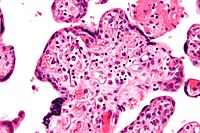
Photo from wikipedia
BACKGROUND Hypospadias is more common among male infants with growth restriction, defined as a birth weight less than the 10th centile, than in infants with a normal birth weight. Intrauterine… Click to show full abstract
BACKGROUND Hypospadias is more common among male infants with growth restriction, defined as a birth weight less than the 10th centile, than in infants with a normal birth weight. Intrauterine growth retardation (IUGR) has been associated, also, with abnormalities of the placenta, such as maternal vascular malperfusion. In a consecutive sample of newborn infants, the association between hypospadias, IUGR and abnormalities of the placenta could be analyzed. METHODS Affected infants were identified among 289,365 liveborn and stillborn infants in the Active Malformations Surveillance Program between 1972 and 2012. The four anatomic locations of the ectopic urethral opening, based on the recorded physical examination findings, were: (1) glandular; (2) subcoronal; (3) penile; (4) penoscrotal. Affected infants with associated malformations, a chromosome abnormality, teratogenic exposure, maternal diabetes mellitus, or multiple gestations were excluded. RESULTS Three hundred sixteen affected infants were identified: 52.2% glandular, 11.7% subcoronal, 27.8% penile, and 8.2% penoscrotal. The highest frequency of IUGR (34.6%) was in the infants with the most severe hypospadias (penoscrotal). The 39 reports of placenta findings showed a high frequency of abnormalities. CONCLUSION An increased rate of occurrence of hypospadias and abnormalities of the placenta were present in infants with intrauterine growth restriction. The postulated cause of this association is a deficiency in the function of the placenta during weeks 10 to 14 of gestation when normal masculinization occurs due to an increase in the level of placental human chorionic gonadotropin and fetal testosterone. The cause of the placental deficiency has not been established. Birth Defects Research 110:122-127, 2018.© 2017 Wiley Periodicals, Inc.
Journal Title: Birth defects research
Year Published: 2018
Link to full text (if available)
Share on Social Media: Sign Up to like & get
recommendations!